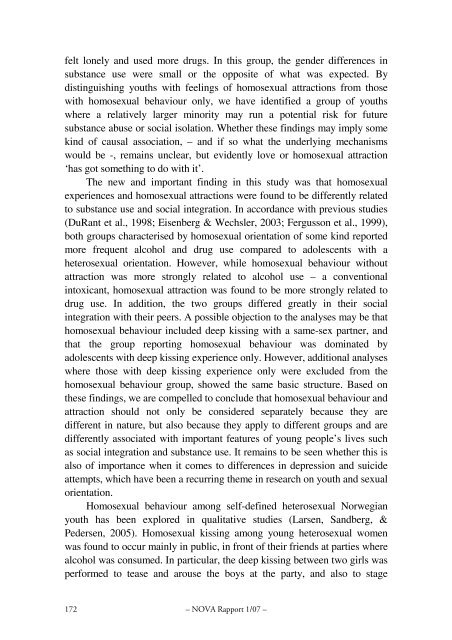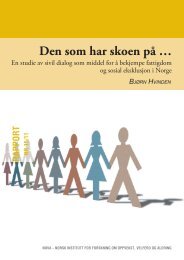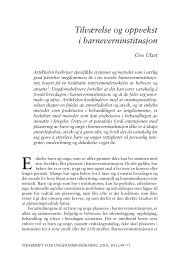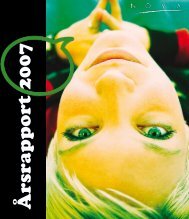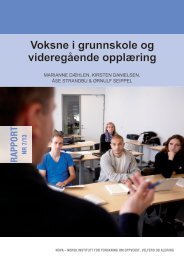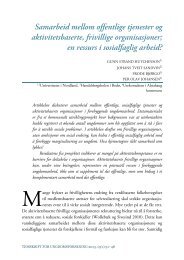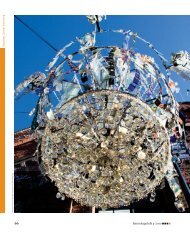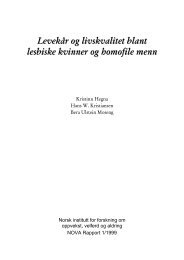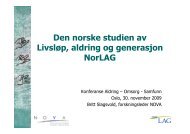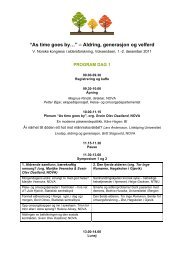Betydningen av seksuell erfaring, tiltrekning og identitet for ...
Betydningen av seksuell erfaring, tiltrekning og identitet for ...
Betydningen av seksuell erfaring, tiltrekning og identitet for ...
You also want an ePaper? Increase the reach of your titles
YUMPU automatically turns print PDFs into web optimized ePapers that Google loves.
felt lonely and used more drugs. In this group, the gender differences in<br />
substance use were small or the opposite of what was expected. By<br />
distinguishing youths with feelings of homosexual attractions from those<br />
with homosexual beh<strong>av</strong>iour only, we h<strong>av</strong>e identified a group of youths<br />
where a relatively larger minority may run a potential risk <strong>for</strong> future<br />
substance abuse or social isolation. Whether these findings may imply some<br />
kind of causal association, – and if so what the underlying mechanisms<br />
would be -, remains unclear, but evidently love or homosexual attraction<br />
‘has got something to do with it’.<br />
The new and important finding in this study was that homosexual<br />
experiences and homosexual attractions were found to be differently related<br />
to substance use and social integration. In accordance with previous studies<br />
(DuRant et al., 1998; Eisenberg & Wechsler, 2003; Fergusson et al., 1999),<br />
both groups characterised by homosexual orientation of some kind reported<br />
more frequent alcohol and drug use compared to adolescents with a<br />
heterosexual orientation. However, while homosexual beh<strong>av</strong>iour without<br />
attraction was more strongly related to alcohol use – a conventional<br />
intoxicant, homosexual attraction was found to be more strongly related to<br />
drug use. In addition, the two groups differed greatly in their social<br />
integration with their peers. A possible objection to the analyses may be that<br />
homosexual beh<strong>av</strong>iour included deep kissing with a same-sex partner, and<br />
that the group reporting homosexual beh<strong>av</strong>iour was dominated by<br />
adolescents with deep kissing experience only. However, additional analyses<br />
where those with deep kissing experience only were excluded from the<br />
homosexual beh<strong>av</strong>iour group, showed the same basic structure. Based on<br />
these findings, we are compelled to conclude that homosexual beh<strong>av</strong>iour and<br />
attraction should not only be considered separately because they are<br />
different in nature, but also because they apply to different groups and are<br />
differently associated with important features of young people’s lives such<br />
as social integration and substance use. It remains to be seen whether this is<br />
also of importance when it comes to differences in depression and suicide<br />
attempts, which h<strong>av</strong>e been a recurring theme in research on youth and sexual<br />
orientation.<br />
Homosexual beh<strong>av</strong>iour among self-defined heterosexual Norwegian<br />
youth has been explored in qualitative studies (Larsen, Sandberg, &<br />
Pedersen, 2005). Homosexual kissing among young heterosexual women<br />
was found to occur mainly in public, in front of their friends at parties where<br />
alcohol was consumed. In particular, the deep kissing between two girls was<br />
per<strong>for</strong>med to tease and arouse the boys at the party, and also to stage<br />
172<br />
– NOVA Rapport 1/07 –


